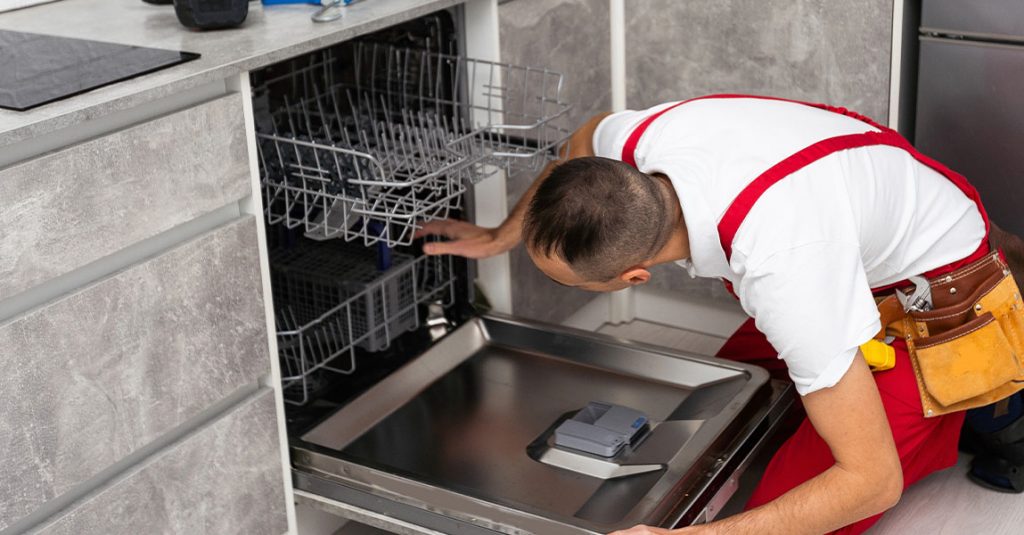We know how stressful it feels when a dishwasher suddenly leaks across the kitchen floor. Water on the ground not only creates a mess but can also cause damage if left unchecked. Instead of panicking, the best step is to slow down and figure out where the water is coming from. Most leaks start from a few common areas, and once you understand these, you can often take quick action before calling for help.
Door Seal Problems
One frequent cause of leaks is the rubber seal around the dishwasher door. This seal, or gasket, keeps water inside the machine during a wash cycle. Over time, the gasket can harden, crack, or collect food debris. When this happens, water slips past the seal and pools on the floor.
We can try wiping the gasket with a damp cloth to clear away food particles. If the rubber feels brittle or appears broken, it usually means replacement is needed. A new gasket is not complicated to install, and it can stop the leak quickly. If this seems overwhelming, scheduling dishwasher repair in Okotoks ensures the seal is properly fitted.
Detergent and Loading Mistakes
Another simple source of leaks comes from how we use the dishwasher. Using the wrong detergent can create excess suds, which overflow through the door or vent. Even filling the soap dispenser with more than recommended can cause foam to build up.
Loading dishes incorrectly may also send water in directions the machine was not designed to handle. Bowls or pans that block spray arms redirect water against the door, leading to small leaks that look like larger problems. Double checking detergent type and making sure spray arms can move freely prevents many of these issues.
Spray Arm Cracks or Blockages
Inside the dishwasher, the spray arms spin and push water across all the dishes. If one of these arms cracks, it can spray directly at the door or joints. Likewise, food particles clogging the nozzles can change the direction of the spray, sending water where it should not go.
We can remove the spray arms and rinse them under running water to clear out clogs. For deeper blockages, a toothpick or soft brush helps. If we notice a crack, it is best to replace the arm instead of trying to patch it. A small break often grows and causes bigger leaks.
Hose and Connection Leaks
Every dishwasher connects to water through hoses and fittings. Over time, these connections loosen or wear out. A leak under the machine often comes from the inlet hose or the drain line. Checking these areas can give quick answers.
We should look for dampness around the hose clamps or fittings and tighten them gently if loose. If a hose feels cracked or worn, replacement is safer than a quick fix. Since water lines can be tricky, many people prefer turning to local help for appliance repair in Okotoks when hoses need changing.
Overfilling and Float Switch Issues
Dishwashers are designed with a float switch that controls how much water enters the tub. If this switch sticks or fails, the machine may take in too much water. The excess then spills out the sides or through vents.
We can inspect the float inside the dishwasher tub. It usually looks like a small dome or cylinder on the floor of the machine. If it does not move freely up and down, cleaning around it may solve the problem. If movement feels stiff, the switch might need professional attention to avoid repeated flooding.
Drainage Problems
When water cannot drain properly, it backs up and leaks out in places we do not expect. Clogs in the filter, drain hose, or even the sink’s garbage disposal can cause this issue.
We should remove and clean the filter at the bottom of the tub. Rinsing the hose with warm water or checking the sink drain for blockages also helps. If water still collects at the bottom after a cycle, the drain pump may be the problem. In that case, arranging service with our team through the contact us page makes sure the pump is repaired before further damage occurs.
Tips to Prevent Future Leaks
Keeping a dishwasher in good condition often prevents most leaks from happening. Wiping the gasket every week, clearing the filter, and checking spray arms are all small habits that protect the machine. Running hot water in the sink before starting a cycle helps keep the wash temperature steady, which also reduces buildup inside the dishwasher.
We also find it helpful to run an empty cycle with dishwasher cleaner once a month. This breaks down grease and food deposits that could lead to clogs or door seal problems. Simple upkeep keeps water inside where it belongs and saves time and stress later.
FAQ
Why does my dishwasher leak only sometimes?
Leaks that happen occasionally may be tied to how dishes are loaded or how much detergent is used. Adjusting these factors often solves the problem.
Can I keep using my dishwasher if it leaks a little?
It is better not to. Even a small leak can cause floor damage over time and may suddenly get worse.
How do I know if the leak is from the hose or the machine?
Check under the dishwasher after running a cycle. If water pools near the back or sides, the hose or connection may be the source.
Do I need a plumber or an appliance technician for leaks?
If the issue is with water lines leading to the machine, a plumber may help. For internal problems like seals, spray arms, or pumps, an appliance technician is best.
How often should I check the filter and gasket?
A monthly check is a good habit. It prevents buildup and helps catch early signs of wear before leaks start.

